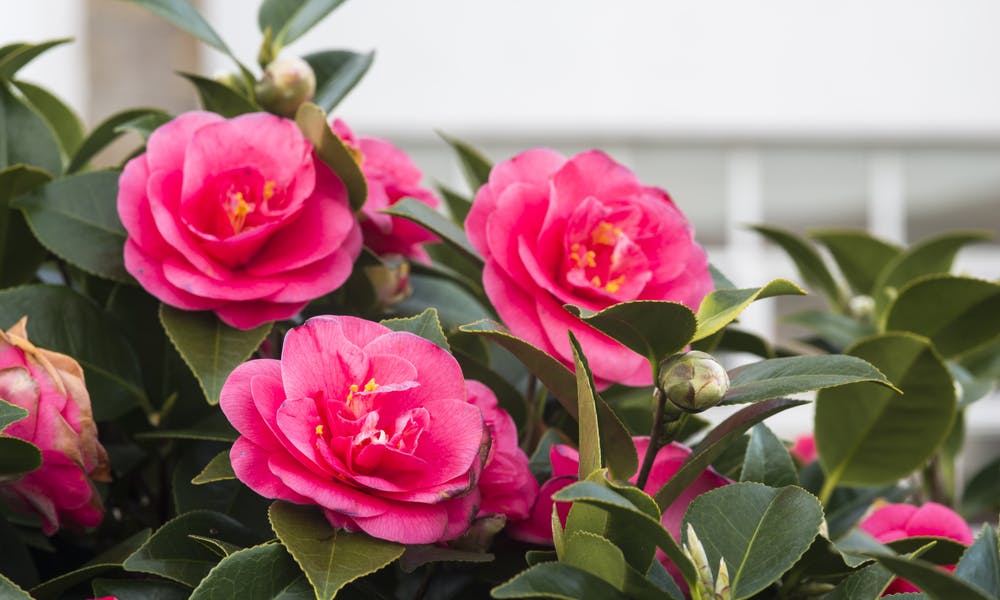MENU
Camellias: Their History, Meaning, and Care

While many flowers go dormant during the months of late fall to mid-spring, camellias, on the other hand, bring vivacious blooms to gardens throughout the mild climate zones stretching from coast to coast of the United States. These majestic plants are long living, some thriving for more than 100 years. They have a deep root in not only in gardens but in culture as well.
As you read this, you can learn the following:
- General Characteristics
- History
- Modern Meaning and Symbolism
- Significance in Culture
- Care
General Characteristics
Camellias originated from the Eastern to Southern regions of Asia. There are between 100 and 300 species. The camellia is a broad leafed, evergreen plant whose flowers come in a variety of shapes: upright, round, and oval. Camellias bloom in several colors ranging from white, pink, red, and combinations. The yellow flower variety is found only in South China and Vietnam. Generally, the flowers have little to no scent.
Camellia plants have a growth rate on average of 30 centimeters per year. In its maturity, the plant reaches a height of 6 feet to 12 feet, and a width of the same dimensions. It is recommended to plant the shrubs with adequate space between them due to its size and its rapid growth rate. Camellias can also be planted in well-draining containers. The plant is a popular choice for gardens due to its nontoxic qualities making it a safe botanical choice around children.
History
The camellia is native to the Orient where it was cultivated for 100s of years before its introduction to Europe. This genus of flower was named after the botanist, Georg Kamal. The leaves of the camellia have been used for tea for centuries. Through selective breeding, the most desirable qualities for tea have been enhanced. The seeds of the camellia were not only used for gardens, but in the home as well. The seeds are pressed to make tea oil, which is used as a seasoning, and it is also used as a cooking oil. This oil is a culinary staple in many Chinese homes. The oil is also used to clean and protect the blades of cutting tools in the kitchen.
The East India Company first brought tea to Europe in the 1600s, which then lead to the introduction of the first living camellias to England in 1739. The expansion of the tea trade in the 18th century increased the demand for different camellia varieties in England.
Modern Meaning and Symbolism
In Japan, before Westernization, it was commonly believed that the gods used the camellia flowers as shelter when they made visits to Earth. It is now a flower that is associated with beheadings because, rather than individual petals falling off, the entire head of the flower drops off. Due to this association, the flower is used more in gardens than as cut flowers in arrangements in the home.
Once the flowers were introduced and used in England, they became associated with the patrons who purchased them for their gardens. In 1794, the double red blooms became associated with Sir Robert Preston. While as the pale pink “Lady Hume’s Blush” was given it moniker in 1806 in honor of Lady Amelia Hume.
Significance in Culture
The camellia plays a significant role in the novel, “To Kill a Mockingbird” by Harper Lee. In the novel, one of the characters destroys a neighbor’s camellia shrub. Once this character makes amends for their mistake, he is given a single white camellia bloom as a symbolic reminder to use compassion when handling an uncomfortable and difficult situation.
In 1944, the town of Temple City, California created a Camellia Festival to celebrate families and youth. During the first parade, children in the procession tossed camellia blossoms to the bystanders. Now, not only do the participants toss blossoms, but the floats are adorned with camellias. The town of Temple City, California, is proudly known as Home of Camellias.
One cannot think of the international company, Chanel, without thinking of its iconic symbol, the camellia. After receiving her first bouquet of camellias, Coco Chanel began wearing a hand-made silk camellia brooch. From that point on, the camellia design has been incorporated into the design of shoes, engraved on buttons, used an appliqué, and part of jewelry designs.
Care
When first establishing camellias in a garden, choose a location that has partial to full shade. Generally, the red varieties can withstand more sun than the white varieties. Be sure the location is also sheltered from strong winds. Give plants adequate space as camellia shrubs grow quite large. Slope soil up to the sides. Camellias require a large amount of water either by rainfall or irrigation. Use a camellia specific fertilizer to ensure the plants are receiving nutrients to support their needs.
For indoor arrangements created from flowers from your garden, follow these steps. First, cut the desired flower’s stem at the base of a branch near where another bud is emerging. Immediately after cutting, submerge the freshly cut stem in a container of water. Be sure to remove leaves from the stem that fall below the water line. With the stem still under water, cut a 2-inch vertical slit at the base. Allow the flowers to sit in the water while you prepare the vase. Rinse the vase with tepid water and a mild soap. Then, add clean water to the vase and a cut flower preservative. To ensure your flowers last, be sure to change the water every other day and trim the ends of the stems when you do.
Conclusion
Camellias bring color and life to winter gardens. With their perfect symmetry, Camellias make a perfect choice not only for gardens but for interior floral arrangements as well. Being the symbol of love, affection, and admiration, they are a popular choice for weddings and bridal bouquets. Camellias bring an elegant refinement not only to homes and gardens, but to special occasions.

